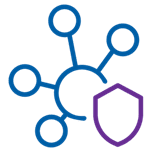
As organizations continue to face increasingly sophisticated cyber threats, the traditional perimeter-based security model has proven inadequate. ZERO Trust architecture has become a cornerstone of modern cybersecurity. At its core, ZERO Trust revolves around one simple principle: trust nothing and verify everything. While the idea is straightforward, achieving this in practice—especially with legacy systems—remains challenging. Continuous, real-time monitoring plays an essential, though often underestimated, role in the success of modern IT strategies.
Beyond Perimeter Security
Past security strategies focused on building walls around the organization—think firewalls, VPNs, and traditional access controls. But today’s threat landscape has made that model obsolete. Insider threats, phishing attacks, ransomware, and sophisticated supply chain attacks have forced organizations to adopt more nuanced security strategies.
Real-time monitoring is key to this shift. While ZERO Trust starts with establishing controls such as multi-factor authentication (MFA) and least privilege access, it doesn’t end there. Real-time monitoring and continuous verification ensure those controls remain effective, especially in complex, dynamic environments where configurations and workloads constantly change.
Rather than simply setting up access controls and walking away, your organization needs to ensure constant visibility into what’s happening within its networks and systems. Real-time monitoring provides this visibility, tracking activities and alerting the security team to any anomalies or suspicious behavior.
For example, a global financial institution using XYGATE SecurityOne (XS1) implemented real-time monitoring to detect policy violations and privilege misuse. Their security team could see in real-time when a user’s permissions were elevated without proper authorization, allowing them to shut down and roll back the suspicious activity before any damage was done. Without real-time monitoring, this would likely have gone unnoticed until much later, when significant damage could have already occurred.
The Components of Effective Monitoring
Effective monitoring is multi-faceted. A robust cybersecurity strategy needs comprehensive visibility into system integrity, user behavior, and network activity. Let’s dive into how these components fit together to create a comprehensive monitoring framework.
- Intelligent Integrity Monitoring
- System integrity monitoring ensures that no changes—whether malicious or accidental—go unnoticed. It’s especially important for mission-critical environments like HPE NonStop, where even minor changes can have significant consequences. By continuously monitoring system files and configurations, organizations quickly detect unauthorized changes, protect against ransomware, and maintain system integrity.
- Behavioral Monitoring and Threat Detection
- User behavior is often the weakest link in cybersecurity. A robust monitoring solution MUST continuously analyze user activity, identifying deviations from the norm that may indicate compromised accounts or malicious insiders. Behavioral monitoring not only enhances ZERO Trust but also provides valuable insights to help refine access policies.
- Network and Appliance Monitoring
- Ensuring the security of hardware appliances such as CLIMs and NonStop consoles is often overlooked. These components are just as vulnerable to attack as software systems. XS1’s Appliance Sentry Monitor provides real-time monitoring and alerts for any suspicious activities on these vital components, ensuring that nothing is overlooked.
In one Case Study, a credit union found that XS1 helped identify unusual port scans and login patterns among their privileged users. After implementing XS1’s behavioral analytics, they were able to identify the source and prevent malicious scans on their system where compromised credentials could be used to escalate privileges.
Automation and AI: Enhancing the Monitoring Process

While monitoring is critical, it can also be overwhelming. The sheer volume of alerts and logs generated by modern IT environments makes manual monitoring nearly impossible. That’s why automation and AI-driven analytics are becoming essential in modern monitoring strategies.
XYGATE SecurityOne (XS1) machine learning algorithms automatically correlate data, highlight actionable incidents, and reduce false positives. This reduces alert fatigue and frees up security teams to focus on incidents that genuinely require attention.
A logistics company that uses XS1 reported a dramatic reduction in investigation times, as AI-driven alerts enabled them to prioritize incidents for immediate attention. Their security team could finally move from a reactive stance—sifting through endless logs—to a proactive strategy focused on prevention.
Use Case: Accelerating Response to Ransomware Threats
Ransomware attacks continue to be a major threat, and continuous monitoring plays a critical role in minimizing their impact. In one very recent case, a major financial institution used XS1 to detect early signs of a ransomware attack targeting their HPE NonStop infrastructure. Real-time alerts on suspicious file modifications were forwarded to their security team to isolate the affected systems within minutes, preventing the ransomware from spreading to other critical systems.
This rapid detection and response not only protected the organization from significant financial loss but also preserved customer trust, a priceless commodity.


Be the first to comment